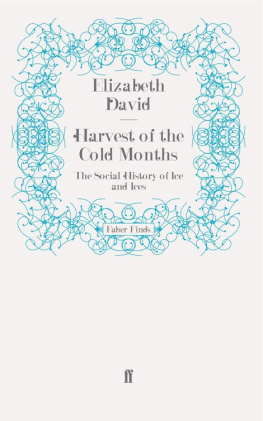Special thanks to Paul Breman who spent weeks sifting through boxes of papers to ensure that none of Mrs Davids original notes were overlooked, then checked references, corrected proofs and generally kept the whole project on track. And to Sasha Breman who typed and retyped, corrected proofs and dealt with most of the correspondence.
Thanks are due to the following persons and institutions for permission to reproduce illustrations:
(p. 10)
(p. )
(p. )
(p. )
(pp. and )
(p. )
(p. )
(p. )
(pl. )
(pl. )
(pl. )
(pl. )
J.N.
We do not know for how many millennia man has exploited the preservative properties of ice, but the earliest recorded ice houses were built at Mari beside the Euphrates river in Mesopotamia almost , years ago. In TheIce-housesofBritain, Sylvia Beamon and Susan Roaf note that cuneiform texts describe an ice pit twice as long as it was deep ( m by m) and lined with tamarisk branches. The ice supply was well guarded, but demand was such that it was almost sold out three days after reaching the city. It was used by the rich to cool their wines and other drinks. There is confirmation in Proverbs (XXV:) of the custom of preserving snow and the value placed upon it: As the cold of snow in the time of harvest, so is a faithful messenger to them that send him: for he refresheth the soul of his masters. And in the Shih Ching, c. 1110 BC , we learn that the ancient Chinese were accustomed to harvesting and storing ice for the summer months (see Cathay to Caledonia).
The Greeks and Romans adopted the use of ice houses and the habit of cooling their drinks from the Middle East. Snow was sold in the markets of Athens from the fifth century BC and according to Pericles was widely used by ordinary people and soldiers as well as by the nobility. A piece of ancient gossip about Diphilus, the comic playwright ( BC ), is recounted by Athenaeus:
Once upon a time Diphilus was invited to Gnathaenas house, to dine, so they say, in celebration of the festival of Aphrodite And one of her lovers, a stranger from Syria, had sent her some snow the snow was to be secretly shaken up in the unmixed wine; then she directed the slave to pour out about
Chares of Mitylene, in his RecordsofAlexander, described how to store snow in pits. It is said that when Alexander conquered Petra in BC he had thirty pits dug, filled with snow and covered with branches of oak.
In TheHistoryofAncientandModernWines, published in 1824 , Alexander Henderson affirms:
The Romans adopted the same mode of preserving the snow, which they collected from the mountains, and which, in the time of Seneca, had become an important article of merchandise at Rome, being sold in shops appropriated to the purpose, and even hawked about the streets At first the only mode of employing snow was by fusing a portion of it in the wine or water which was to be cooled; and this was most conveniently effected by introducing it into a strainer (columnivarium), which was usually made of silver, and pouring the liquid over it. But as the snow had generally contracted some degree of impurity during the carriage, or from the reservoirs in which it was kept, the solution was apt to be dark and muddy, and to have an unpleasant flavour from the straw: hence those of fastidious taste preferred ice, which they were at pains to procure from a great depth, that they might have it as fresh as possible A more elegant method of cooling liquors came into vogue during the reign of Nero, to whom the invention was ascribed; namely, by placing water, which had been previously boiled, in a thin glass vessel surrounded with snow, so that it might be frozen without having its purity impaired.
All around the Mediterranean, snow from the mountain ranges was carried to the ice stores of the cities. The Mamluk kings of Egypt had snow shipped from Lebanon to Cairo in the thirteenth and fourteenth centuries. In Spain there are records of snow pits being dug on the order of Carlos III of Navarre ( 1387 1435 ). A pilgrim to the Holy
The earliest modern documentation of the ice trade in Italy dates from the fifteenth century. Much of the early ice gathering was on a small scale, as people collected ice from ponds and stored it in pits. By the seventeenth century a substantial ice industry had developed in the Lessini mountains in Friuli, and ice was sent overnight by cart to the wealthy citizens of Verona, Venice and Mantua.
At this time many estates had their own ice houses and ice ponds. A detail from the 1693 manuscript map of the country estate at Olmo of the hospital of Santa Maria Nuova in Florence shows the ice ponds and ice house situated quite near to the fattoria













